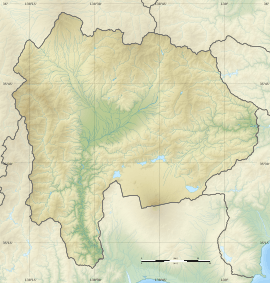Kinsei ruins
Kinsei ruins (金生遺跡, Kinsei iseki) is an archaeological site consisting of the ruins of a late to final Jōmon period settlement, located in what is now part of the city of Hokuto, Yamanashi in the Chūbu region of Japan. The site was designated a National Historic Site of Japan in 1983.[1]
金生遺跡 | |
Kinsei ruins | |
 Kinsei ruins  Kinsei ruins (Japan) | |
| Location | Hokuto, Yamanashi, Japan |
|---|---|
| Region | Chūbu region |
| Coordinates | 35°50′54″N 138°23′07″E |
| History | |
| Periods | Jōmon period |
| Site notes | |
| Ownership | National Historic Site |
Overview
The site is located in former Ōizumi town, on a ridge near the middle of the southern foot of Mount Yatsugatake at an altitude of 770 meters. It consists of two separate sites. In Site A, the foundations of 41 pit dwellings were discovered, 38 of which are from the final period of the Jōmon period (1000–300 BCE). In addition, pottery shards, stone tools, containers and tools made from bone were found from both within and outside of these building foundations. The site also included a ritual area with stone circles, which also contained ritual objects (included over 200 human-shaped clay figurines), earrings, and human bone fragments. The presence of 138 lower jaws from wild boar indicates that these animals were used as some form of sacrifice, perhaps similar to the iomante ceremony conducted by the Ainu people with black bears.
From Site B district, more than 10 buildings with pillar hole rows, surrounded by a moat were discovered. The site included a water reservoir and 49 underground structures which were probably tombs. Excavated artifacts included items originating from distant areas of Japan. Site B appears to have been inhabited into the Heian period.
The site is now preserved as an archaeological park by the city of Hokuto with some faux reconstructed buildings
References
- "金生遺跡" (in Japanese). Agency for Cultural Affairs.
External links
![]()
- Yamanashi Prefectural official site (in Japanese)
- Hokuto city official site {ja}}